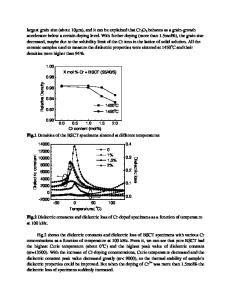Effects of CaHfO 3 on the electrical properties of Bi 0.49 Na 0.49 Ca 0.02 TiO 3 ferroelectric ceramics
- PDF / 3,028,427 Bytes
- 11 Pages / 595.276 x 790.866 pts Page_size
- 85 Downloads / 309 Views
Effects of CaHfO3 on the electrical properties of Bi0.49Na0.49Ca0.02TiO3 ferroelectric ceramics Yong Liu1,3, Yujie Zhang1, Liufang Meng1,2,*, Xiao Liu1, Changrong Zhou1,2, Xinyu Liu1,2, and Changlai Yuan1,2,* 1
College of Material Science and Engineering, Guilin University of Electronic Technology, Guilin 541004, People’s Republic of China Guangxi Key Laboratory of Information Materials, Guilin University of Electronic Technology, Guilin 541004, People’s Republic of China 3 China Nonferrous Metals (Guilin) Geology and Mining Co,.Ltd, Guilin 541004, People’s Republic of China 2
Received: 10 March 2020
ABSTRACT
Accepted: 28 July 2020
(1 - x) (Bi0.49Na0.49Ca0.02TiO3)-xCaHfO3 (BCNTH-x, x = 0.01, 0.02, 0.03, 0.035, 0.04) systems were prepared by solid-state reaction method. Their microstructures, dielectric/piezoelectric/ferroelectric properties and impedance spectroscopy were investigated. All compositions demonstrated a single orthorhombic structure with Pbnm space group. Temperature-dependent permittivity curves displayed one anomaly, which shifts to low temperature from 278 to 208 °C with increased CaHfO3 content, because of the replacement of Hf4? for Ti4? at the B-site that reduced B-site cation ordering. Analysis of dielectric and ferroelectric properties indicated that a crossover from typical ferroelectrics to relaxor ferroelectrics occurred in BCNTH-0.03 and BCNTH0.035 ceramics. The largest electrostrictive strain of 0.22% and the lowest coercive field of 37.7 kV/cm were achieved in BCNTH-0.035 and BCNTH-0.03 ceramics under 100 kV/cm, respectively. Ferroelectric domain and domain wall were fitted by impedance complexes, and the corresponding activation energy was 0.46 and 1.18 eV, which may be correlated to the combination of motion of the first ionization of oxygen vacancies and doubly ionized oxygen vacancies, respectively.
Ó
Springer Science+Business
Media, LLC, part of Springer Nature 2020
1 Introduction Piezoelectric ceramics are extensively investigated due to their wide-ranging applications in sensors, non-volatile memories, and pyroelectric detectors,
among others [1]. Lead-based piezoelectric ceramics with high strain, such as Pb(Zr, Ti)O3 [2], (Pb,La)(Zr, Ti)O3 [3] etc. [4–6]. are commonly used. Lead-based piezoelectric materials almost dominate the market for piezoelectric materials by PZT. However, lead-
Yong Liu and Yujie Zhang contributed equally to this work.
Address correspondence to E-mail: [email protected]; [email protected]; [email protected]
https://doi.org/10.1007/s10854-020-04116-w
J Mater Sci: Mater Electron
containing piezoelectric materials produce substantial lead pollution in the process of production, use and waste, which greatly harms the environment and human body. Hence, developing new leadless piezoelectric materials is urgent. Among lead-free systems, BNT-based lead-free piezoelectric ceramics have the greatest potential to replace PZT because they possess characteristics, such as strong ferroelectricity and high piezoelectric properties [7, 8]. Pure BNT ce
Data Loading...











